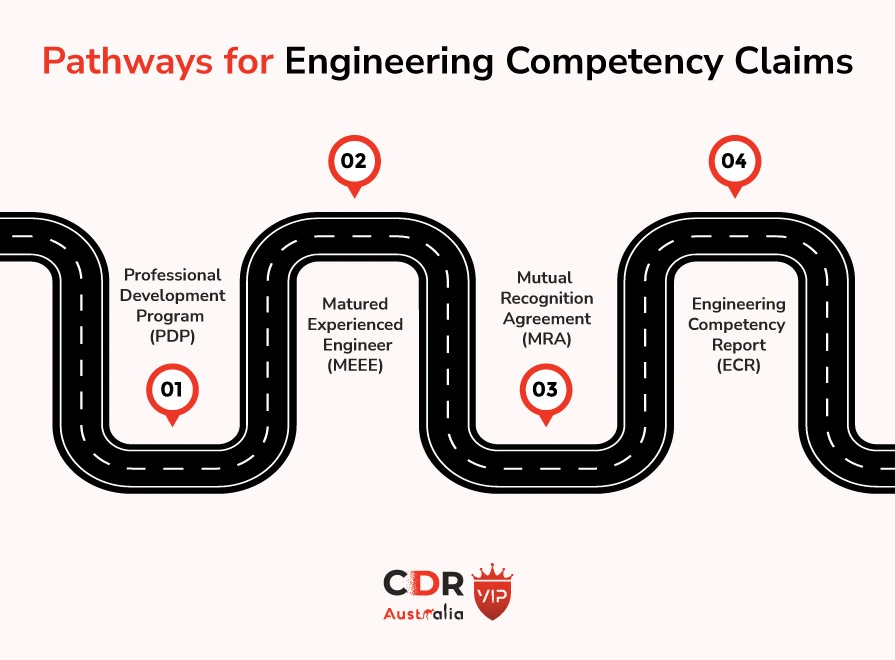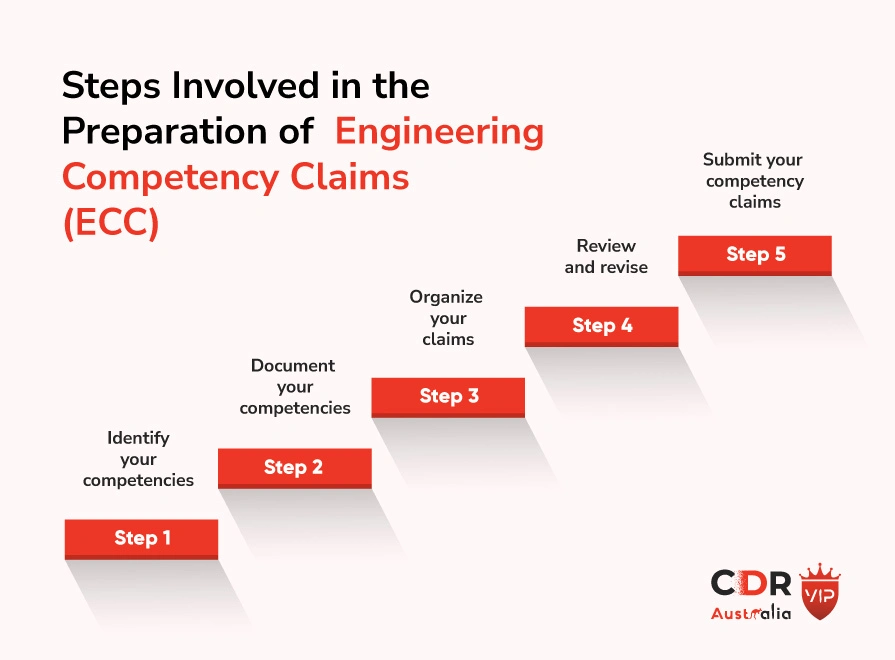What are Engineering Competency Claims?

What are Engineering Competency Claims?
Engineering competency is essential for ensuring engineering projects’ safety, reliability, and performance. Chartered Competencies, Engineering Competency Claims (ECC), and Engineering Competency Reports (ECR) are critical tools to assess and certify engineering competency.
In Australia, Engineers Australia plays a crucial role in determining and accrediting engineering competencies through a rigorous process of evaluation. Engineering Competency Claims (ECC) are crucial for professional engineers to demonstrate their knowledge, skills, and abilities required for different engineering roles and levels.
It helps employers and the industry identify skilled workers and make informed decisions about hiring promotion and professional development opportunities. In Australia, the Australian and New Zealand Standard Classification of Occupations (ANZSCO) provides classification guidelines for engineering positions, including engineering technician, manager, and system engineer.
ECCs define the technical competencies required for each ANZSCO level, ensuring that engineers possess the necessary expertise. This blog explores the importance of engineering competency claims in Australia and how they get assessed.
What are Engineering Competency Claims in Australia?
Engineering competency claims are an essential aspect of professional engineering practice in Australia. Competency assessed in engineering competency claims typically involves various competence elements, which get considered through submitting multiple documents, including the Career Episode, Engineering Experience Record, and CDR samples.
Some of the most common engineering competency claims in Australia include the following:
1. Technical Competence
Technical competence applies scientific principles and engineering concepts to design, analyze, and solve engineering problems. It includes knowledge of fundamental tenets such as mechanics, thermodynamics, and materials science and specialized expertise in structural, electrical, and environmental engineering.
2. Design Competence
Design competence refers to developing creative and innovative solutions to engineering problems. It includes knowledge of design methods, tools, and techniques and the ability to evaluate alternative solutions and make informed decisions based on technical and economic considerations.
3. Project Management Competence
Project management competence refers to effectively planning, organizing, and managing engineering projects. It includes knowledge of project management principles and practices and the ability to manage resources, schedules, budgets, and risks.
4. Communication Competence
Communication competence means communicating effectively with stakeholders, including clients, colleagues, and the general public. It includes writing clear and concise reports, making effective presentations, and engaging in constructive dialogue.
5. Ethics and Professionalism
Ethics and professionalism refer to the ethical standards and values of engineering practice. It includes knowledge of professional codes of ethics and the ability to identify and address ethical dilemmas and conflicts of interest.
Read More: Onshore and Offshore Visa Application 💪💪
Why are Engineering Competency Claims Important in Australia?
Engineering competency claims are essential for several reasons in Australia. First, they ensure that professional engineers have the knowledge, skills, and abilities to design, build, and maintain safe and reliable engineering projects. This claim is essential in civil and aerospace engineering, where even minor errors can have catastrophic consequences.
Engineering competency claims are significant in Australia for several reasons, including engineering career development and certification. These claims get used to assess the competency of engineers based on specific competence elements, such as design, project management, communication, ethics, and professionalism.
Engineering competency claims get assessed through various methods, including the engineering experience record, career episodes, and competency demonstration reports (CDR samples). These examples help engineers provide evidence of their engineering competencies, and the Engineers Australia Chartered Competencies get used as a framework for this assessment.
By setting high standards for professional competence and ethical conduct, engineering competency claims ensure the safety and reliability of engineering projects, maintaining the public’s trust and confidence in the engineering profession.
Second, engineering competency claims provide a framework for professional development and lifelong learning. Defining the essential competencies for engineering practice gives engineers a roadmap for developing their skills and knowledge. This claim is significant in Australia, where the engineering profession is rapidly evolving due to technological advances and changes in the global economy.
Finally, engineering competency claims are essential for ensuring public trust and confidence in the different engineering professions in Australia. By setting high standards for professional competence and ethical conduct, they help maintain the integrity and reputation of the engineering profession and ensure that the public can have confidence in the safety and reliability of engineering projects.
Read more: Computer Engineer Jobs in Australia 💼💼
Pathways for Engineering Competency Claims
Different pathways enable engineers to demonstrate their competence through various means, such as a portfolio of engineering experience records, career episodes, and competency assessments based on the Engineers Australia Chartered Competencies.
A well-prepared engineering competency report example can significantly facilitate the assessment process and increase the chances of successful certification. The four pathways for engineering competency claims in Australia are:

1. Professional Development Program (PDP)
The PDP is a structured program to support the ongoing development of engineers’ skills and knowledge throughout their careers. It consists of three stages: Planning, Implementation, and Review. The program requires engineers to maintain their Chartered Professional Engineer status with Engineers Australia.
2. Matured Experienced Engineer (MEEE)
This pathway is for engineers who do not hold a recognized qualification but have significant industry experience. Engineers must have at least 15 years of experience, with at least five years in a senior technical or engineering management role.
3. Mutual Recognition Agreement (MRA)
This pathway is for registered engineers with a recognized overseas engineering body. Engineers must have completed a recognized qualification and at least three years post-registration experience.
4. Engineering Competency Report (ECR)
This pathway is for engineers who still need to meet the requirements of the other tracks. Engineers must submit an Engineering Competency Report demonstrating their competency in their engineering field. A Chartered Professional Engineer must prepare the report and assesses the engineer’s knowledge, skills, and experience against the relevant competency standards.
Each pathway has requirements and assessment criteria that engineers must meet to demonstrate competency in their respective fields. By completing the relevant path, engineers can obtain professional registration with Engineers Australia and demonstrate their competence to potential employers and clients.
Read More: Step-by-step process to get an Australian PR in 2023 💪💪
Principles of Engineering Competency Claims
These principles ensure that engineering competency claims get evaluated fairly and accurately and that engineers possess the necessary knowledge, skills, and abilities to practice engineering safely and effectively. Below are those principles:
1. Authenticity
Competency claims should be authentic, meaning they accurately reflect the knowledge, skills, and abilities of the engineer making the claim. Claims should get supported by evidence, such as specific examples of work that demonstrate the application of competencies.
2. Validity
Competency claims should be valid, meaning they measure what they intend to measure. Claims should be based on a clear understanding of the competencies required for a particular engineering discipline or project type and should get aligned with industry standards and best practices.
3. Reliability
Competency claims should be reliable, producing consistent results when evaluated by different assessors. Claims should get evaluated using objective criteria and compatible with other sources of evidence, such as job performance evaluations or peer reviews.
4. Current
Competency claims should be current, reflecting the most up-to-date knowledge, skills, and practices in a particular engineering discipline. Engineers should engage in ongoing professional development activities to maintain and enhance their competencies.
5. Sufficiency
Competency claims should be sufficient, providing an accurate picture of the engineer’s competencies. Claims should include a range of examples that demonstrate the application of competencies in different contexts and should get organized in a way that is clear and easy to understand.
By following these principles, engineers can prepare effective competency claims to enhance their career prospects and demonstrate their professional competence as engineers.
Components of Engineering Competency Claims
The components of Engineering Competency Claims (ECC) in Australia are as follows:
1. Personal commitment
This component focuses on an engineer’s commitment to professional development and lifelong learning. Engineers must demonstrate their commitment to ongoing learning and development activities and the importance of staying up-to-date with industry trends and developments.
2. Community application
This component emphasizes the engineer’s ability to apply technical knowledge and skills to benefit the wider community. Engineers must demonstrate their ability to work collaboratively and communicate effectively with stakeholders, including clients, colleagues, and the public.
3. Workplace value
This component focuses on an engineer’s ability to contribute to their workplace and add value to their organization. Engineers must demonstrate their ability to work independently and as part of a team, manage projects, and solve complex problems.
4. Technical proficiency
This component assesses an engineer’s technical knowledge and skills in various areas of expertise. Engineers must demonstrate their understanding of engineering principles and practices and their ability to apply this knowledge to real-world situations.
These four components form the basis for assessing Engineering Competency Claims in Australia. The assessment process is rigorous and designed to ensure that engineers are competent to practice engineering safely and effectively. Engineers must demonstrate proficiency in these areas to obtain professional registration with Engineers Australia.
Assessing Engineering Competency Claims in Australia
Assessing engineering competency claims in Australia involves thoroughly evaluating an engineer’s engineering experience record, career episodes, and competency assessed. Engineers must demonstrate competence in the various competence elements outlined in the Engineers Australia Chartered Competencies.
The process involves a review of engineering competency reports, which include examples of successful engineering projects and how they met the competency claims. The assessment process ensures that engineers have the necessary competencies for engineering certification and career development.
In Australia, the process of becoming a licensed professional engineer involves several stages, including:
1. Education
In Australia, professional engineers get typically required to have a minimum level of education, commonly a four-year bachelor’s degree in engineering or a related field. Some states in Australia may also need a master’s degree or additional coursework in specific areas of engineering.
2. Training
Professional engineers in Australia are typically required to complete a period of supervised training, often referred to as an engineering internship or engineering apprenticeship. This period of training provides engineers with hands-on experience working on engineering projects under the supervision of a licensed professional engineer.
3. Experience
Professional engineers in Australia get typically required to have a minimum amount of engineering experience before they can apply for licensure. The exact amount of experience required may differ depending on the state or territory but generally ranges from 3 to 5 years of engineering experience.
4. Examination
In Australia, professional engineers get typically required to pass a licensing examination to demonstrate their knowledge and competency in engineering practice. These examinations usually cover various technical and ethical topics and may be administered by a professional engineering licensing board or regulatory agency.
As a manager under ANZSCO or NEC ANZSCO, it is crucial to assess their ability to work collaboratively, communicate effectively, work independently, manage projects, and solve complex problems.
Test engineers can demonstrate their writing perfection and engineering competency claims (ECC) to add value to their work and benefit the wider community. These codes will ensure that test engineers can contribute effectively to their organization and help achieve its goals.
Must Read: Top 10 most-demanded engineering fields in Australia 📚📚
Steps Involved in the Preparation of ECC
Preparing effective engineering competency claims involves several steps essential for demonstrating your professional competence and enhancing your career prospects which are as follows:

Step 1: Identify your competencies
The first step in preparing effective engineering competency claims is to identify the competencies relevant to your professional practice and the engineering projects you have worked on. This step generally involves reviewing your job description, project reports, and professional development activities to identify the competencies that you have developed.
Step 2: Document your competencies
Once you have identified your competencies, the next step is to document them using clear and concise language. Consider the context in which you will present your competency claims and ensure that your claims are relevant to the audience. Use the STAR method to provide specific examples of how you have applied your competencies in real-world engineering projects.
Step 3: Organize your claims
Organize your competency claims into categories or sections that are easy to navigate and understand. This stage may involve grouping your competencies into technical and non-technical categories or organizing them by project type or engineering discipline.
Step 4: Review and revise
Once you have organized your competency claims, please review them carefully to ensure they are accurate, relevant, and concise. Ask a colleague or mentor to check your claims and provide feedback on their clarity and effectiveness. Revise your claims as necessary based on the feedback you receive.
Step 5: Submit your competency claims
Once you have prepared your competency claims, please submit them to the appropriate authority or organization for evaluation. This step may involve submitting them as part of a job application, a professional development program, or a certification process.
Read more: Top 10 reasons for CDR Rejection 💼💼
Conclusion
By assessing engineering competency claims in Australia, the engineering profession can ensure that engineers have the knowledge, skills, and capabilities to practice engineering safely and effectively.
As such, engineers in Australia must stay abreast of the latest growth in the field and maintain their engineering competencies, as exemplified in the Engineers Australia Stage 1 Competency Example and Engineering Competency Report Example, to sustain the profession’s success.
In conclusion, Engineers Australia’s competencies and engineering competency claims play a significant role in ensuring that engineering projects in Australia meet high safety and reliability standards. Professional development, lifelong learning, engineering career development, and certification help engineers maintain their competency claims.


